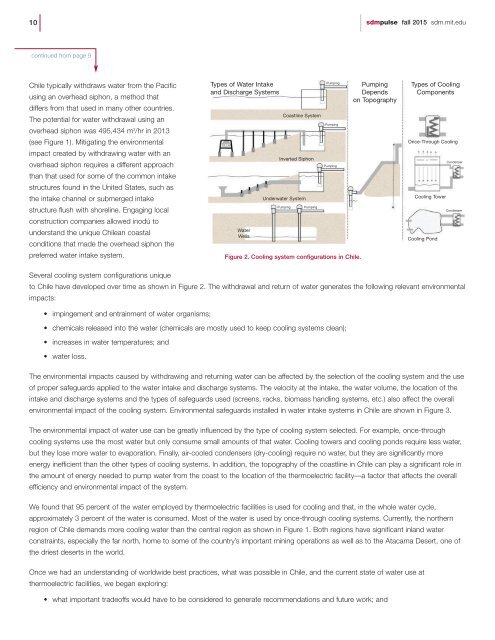sdm pulse
SDM-Pulse-Fall-2015
SDM-Pulse-Fall-2015
Create successful ePaper yourself
Turn your PDF publications into a flip-book with our unique Google optimized e-Paper software.
10 <strong>sdm</strong><strong>pulse</strong> fall 2015 <strong>sdm</strong>.mit.edu<br />
continued from page 9<br />
Chile typically withdraws water from the Pacific<br />
using an overhead siphon, a method that<br />
differs from that used in many other countries.<br />
The potential for water withdrawal using an<br />
overhead siphon was 495,434 m 3 /hr in 2013<br />
(see Figure 1). Mitigating the environmental<br />
impact created by withdrawing water with an<br />
overhead siphon requires a different approach<br />
than that used for some of the common intake<br />
structures found in the United States, such as<br />
the intake channel or submerged intake<br />
structure flush with shoreline. Engaging local<br />
construction companies allowed inodú to<br />
understand the unique Chilean coastal<br />
conditions that made the overhead siphon the<br />
preferred water intake system.<br />
Types of Water Intake<br />
and Discharge Systems<br />
Water<br />
Wells<br />
Coastline System<br />
Inverted Siphon<br />
Underwater System<br />
Pumping<br />
Pumping<br />
Pumping<br />
Pumping<br />
Pumping<br />
Figure 2. Cooling system configurations in Chile.<br />
Pumping<br />
Depends<br />
on Topography<br />
Types of Cooling<br />
Components<br />
Once-Through Cooling<br />
Cooling Tower<br />
Cooling Pond<br />
Condenser<br />
Condenser<br />
Several cooling system configurations unique<br />
to Chile have developed over time as shown in Figure 2. The withdrawal and return of water generates the following relevant environmental<br />
impacts:<br />
• impingement and entrainment of water organisms;<br />
• chemicals released into the water (chemicals are mostly used to keep cooling systems clean);<br />
• increases in water temperatures; and<br />
• water loss.<br />
The environmental impacts caused by withdrawing and returning water can be affected by the selection of the cooling system and the use<br />
of proper safeguards applied to the water intake and discharge systems. The velocity at the intake, the water volume, the location of the<br />
intake and discharge systems and the types of safeguards used (screens, racks, biomass handling systems, etc.) also affect the overall<br />
environmental impact of the cooling system. Environmental safeguards installed in water intake systems in Chile are shown in Figure 3.<br />
The environmental impact of water use can be greatly influenced by the type of cooling system selected. For example, once-through<br />
cooling systems use the most water but only consume small amounts of that water. Cooling towers and cooling ponds require less water,<br />
but they lose more water to evaporation. Finally, air-cooled condensers (dry-cooling) require no water, but they are significantly more<br />
energy inefficient than the other types of cooling systems. In addition, the topography of the coastline in Chile can play a significant role in<br />
the amount of energy needed to pump water from the coast to the location of the thermoelectric facility—a factor that affects the overall<br />
efficiency and environmental impact of the system.<br />
We found that 95 percent of the water employed by thermoelectric facilities is used for cooling and that, in the whole water cycle,<br />
approximately 3 percent of the water is consumed. Most of the water is used by once-through cooling systems. Currently, the northern<br />
region of Chile demands more cooling water than the central region as shown in Figure 1. Both regions have significant inland water<br />
constraints, especially the far north, home to some of the country’s important mining operations as well as to the Atacama Desert, one of<br />
the driest deserts in the world.<br />
Once we had an understanding of worldwide best practices, what was possible in Chile, and the current state of water use at<br />
thermoelectric facilities, we began exploring:<br />
• what important tradeoffs would have to be considered to generate recommendations and future work; and


